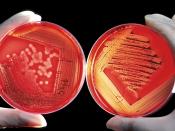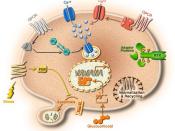Well Written Paper Excellent
Cell Culture Methodology From Donor to Cell Lines
Cellular tissue culture has come a long way since the beginning of the 20th century. Published papers in the early 1900ùs report a theory and a procedure, although harsh and crude, to keep cells alive in media, and those cellsù behavior in vitro would be similar cells in vivo. The advantages of these cell cultures soon came into perspective, medical research could soar from this. Certain difficulties were soon overcome and a serum free media was produced, allowing a huge repertoire of cell lines to be produced. These cell lines created a diversity, allowing scientist to look at how different species of cells could respond to different things.
To produce a cell line worth studying, the first thing that has to be considered is contamination. Cell and tissue culture work requires that cultures are free of contamination microorganisms.
The harvest site is sterilized, and sterile instruments are used throughout any procedure when working with the tissue. Next, the overall health of the cells being taken is examined. Tissue culture also requires that the procedure starts with healthy cells, or the experiment will probably not work.
Once the tissue is collected, it undergoes a mincing process to break apart the cells, i.e. mechanical dissociation. After mincing, the chunks of tissue are exposed to proteolytic enzymes and mechanically agitated. A number of chemicals can be used for tissue dissociation to liberate individual cells, but trypsin and collagenase are most often used. When the desired amount of cells are attained, the cells are washed, rinsed, and put into fresh medium. Cells suited for growth in the culture vessels undergo rounds of growth and mitotic reproduction. The primary culture, when it becomes too crowded can be subcultured by making a one-to-one or...


